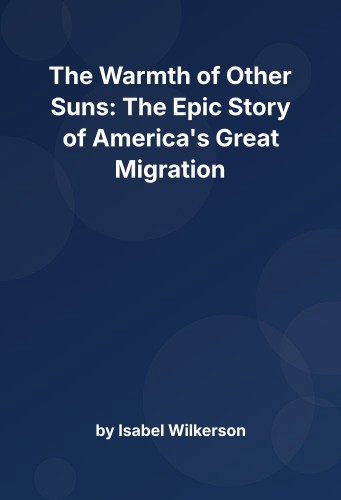Summary of “The Warmth of Other Suns”
Isabel Wilkerson’s “The Warmth of Other Suns: The Epic Story of America’s Great Migration” offers a profound exploration of the Great Migration, a pivotal movement that reshaped the demographic, cultural, and political landscapes of the United States in the 20th century. Through meticulous research and vivid storytelling, Wilkerson chronicles the journeys of three individuals who represent the larger migration of approximately six million African Americans from the rural South to urban centers in the North, Midwest, and West. This migration, which took place from about 1916 to 1970, was driven by the oppressive racial climate in the South and the promise of better opportunities elsewhere.
Core Frameworks and Concepts
Wilkerson’s narrative is structured around three central figures: Ida Mae Brandon Gladney, George Starling, and Robert Foster. Each character’s journey is emblematic of different phases and experiences of the migration. By focusing on these individuals, Wilkerson provides a human face to the statistical and historical data, making the narrative more relatable and impactful.
Framework of Migration
-
Push Factors: The conditions in the South that compelled African Americans to leave, such as Jim Crow laws, economic hardship, and racial violence. For instance, Ida Mae fled Mississippi after a relative was nearly lynched for a minor offense.
-
Pull Factors: The attractions of the North and West, including job opportunities, political freedom, and less institutionalized racism. George Starling was drawn to the educational and social prospects of New York, seeking to escape the oppressive citrus groves of Florida.
-
Transition and Adaptation: The challenges faced during the migration and in the new environments, such as housing discrimination, new social dynamics, and cultural adjustments. Robert Foster, for example, struggled with professional barriers in Los Angeles despite his medical qualifications.
Comparison with Similar Works
Wilkerson’s work can be compared to Nicholas Lemann’s “The Promised Land: The Great Black Migration and How It Changed America,” which also delves into the transformative effects of the migration. While Lemann focuses more on the economic and political ramifications, Wilkerson’s narrative is deeply personal, offering a psychological and emotional perspective. Similarly, Michelle Alexander’s “The New Jim Crow” examines the systemic racism that persisted even after the migration, highlighting the criminal justice system’s role in maintaining racial disparities. These comparisons underscore the multifaceted impact of the Great Migration, revealing both progress and ongoing challenges.
Key Themes
1. The Quest for Freedom
The Great Migration was fundamentally a quest for freedom, not just from physical oppression but from the psychological chains of fear and inferiority imposed by Jim Crow laws. This theme resonates with the struggles depicted in Richard Wright’s “Native Son,” where the protagonist’s life is constrained by systemic racism. In both works, the pursuit of freedom involves significant personal risk and sacrifice.
2. The Role of Community
Community played a crucial role in the migration process. Networks of family and friends provided information, support, and sometimes a place to stay upon arrival in new cities. This mirrors the themes in “The Warmth of Other Suns,” where Ida Mae’s journey is supported by a web of personal connections that help her navigate the complexities of Chicago.
3. Cultural Transformation
The influx of Southern African Americans into Northern and Western cities led to significant cultural transformations. This migration contributed to the richness of urban culture, influencing music, art, cuisine, and social norms. Wilkerson’s narrative parallels works like “The Souls of Black Folk” by W.E.B. Du Bois, which explores the cultural identity and heritage of African Americans.
4. Economic Mobility and Hardship
The promise of economic mobility was a significant lure for migrants. However, the reality often involved continued hardship and discrimination. The experiences of Wilkerson’s subjects reflect the economic struggles detailed in “The Promised Land,” where many migrants found themselves in low-paying jobs despite their skills and aspirations.
5. The Persistence of Racism
Despite moving to regions with less overt racism, African Americans still faced significant discrimination in housing, employment, and social interactions. This persistence is a central theme in “The New Jim Crow,” which argues that systemic racism evolved rather than vanished.
Final Reflection
“The Warmth of Other Suns” is more than a historical narrative; it is a window into the enduring human spirit in the face of systemic oppression. By weaving together individual stories with broader historical contexts, Wilkerson not only educates but also inspires empathy and understanding. Her work prompts reflection on the progress made and the challenges that remain in achieving true racial equality.
In the context of leadership and change, the book highlights the resilience and agency required to navigate oppressive systems, offering valuable lessons for change-makers in various fields. The experiences of Ida Mae, George, and Robert illustrate the power of determination and community support in overcoming adversity, principles that are equally applicable in business, social movements, and personal development. As we reflect on this monumental shift in American history, Wilkerson’s narrative serves as a reminder of the complexities of migration, the ongoing struggle for civil rights, and the importance of understanding our collective past to forge a more equitable future.

